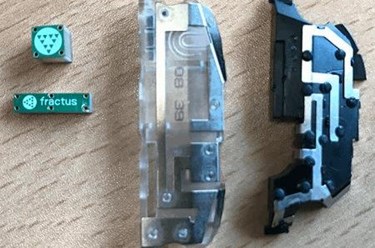Why Multi-Band Smartphones Can Do Away With Antennas
By Jof Enriquez,
Follow me on Twitter @jofenriq

Current and future smartphones that combine spectrum from several frequency bands can function without a typical antenna, thanks to a tiny "booster" device that can radiate RF signals from the smartphone itself.
For many years in the 2000s, mobile phones utilized fractal-designed antennas, identifiable by a squiggly metal line attached to a plastic mold inside the top of the phone. In recent years, manufacturers have moved away from this design and instead simply used a metal band along the top. But these metal bands are unable to handle multiple frequencies simultaneously, and companies typically need to add an active tuner to transmit and receive signals from multiple frequencies.
Current smartphones also use a smartphone's ground plane – the copper layer that underlies the phone’s printed circuit board – to radiate RF signals. Taking this concept further, Fractus Antennas’ mXTEND Antenna Booster device stores the signal it receives, and repeatedly bounces it over to the ground plane, which radiates the signal out to the nearest broadcast to the cell tower or Wi-Fi router.
“Instead of having an antenna that radiates inside the phone, the phone itself is radiating,” Carles Puente, Fractus Antennas’ cofounder and vice-president for innovation, told IEEE Spectrum.
A smartphone's internal circuitry needs some tweaking, though, for the antenna booster to work as effectively as typical antennas. Puente says the matching network – the part of a smartphone that acts like a tuner to support service at various frequencies – needs to have six or seven components, rather than the one or two found in a typical smartphone. Also, the network needs to be reconfigured properly for each model.
Barcelona-based Fractus Antennas claims that it has sold hundreds of thousands of units to a dozen clients who are using them to track fleets of trucks and outfit sensors for smart metering. The company was present at Mobile World Congress a few weeks ago to showcase its device, which measures one-tenth the size of a traditional antenna, but supports at least 12 frequency bands (from 698 MHz to 2690 MHz), and can be adapted for Wi-Fi and Bluetooth. Puente says consumers may see a smartphone model with a Fractus Antennas’ booster device as early as 2018, especially as more networks lean toward carrier aggregation to increase bandwidth.
But as mobile tech R&D becomes more competitive, similar antenna-less technology could start to show up in new smartphone models. Fractus Antennas’ predecessor company in 2011 settled a patent litigation suit against a group of mobile phone manufacturers including LG, HTC, Samsung, Sharp and Blackberry (RIM), which it accused of copying the company’s breakthrough antenna technologies in consumer units. The European startup received $100 million from the tech companies, and a separate $23 million from Samsung for patent infringement.
